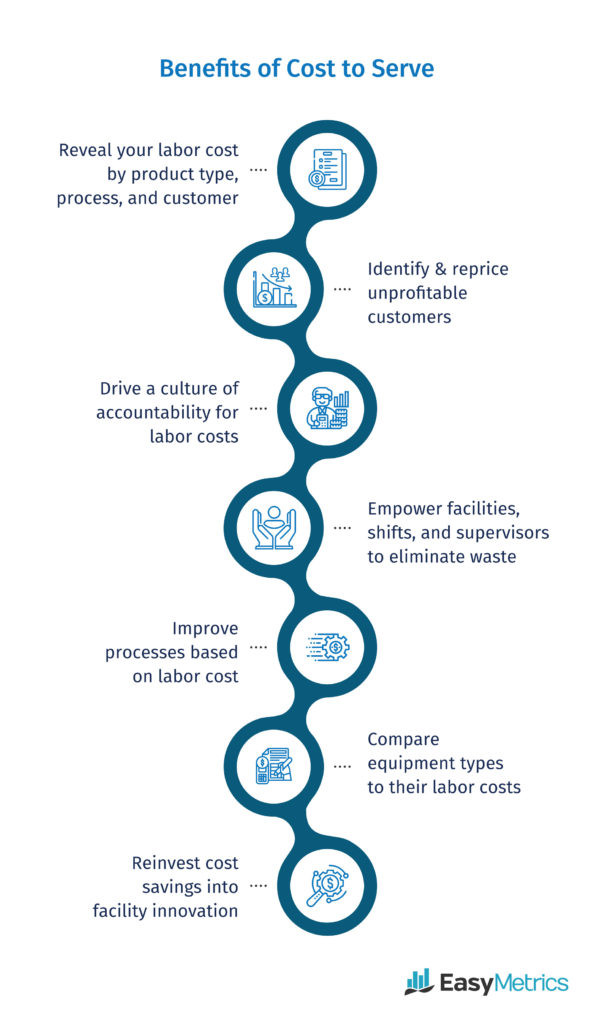Cost To Serve is a critical metric that measures all the expenses involved in serving a customer or producing a product. When you analyze cost to serve alongside revenue, you gain a powerful tool to accurately assess profitability across different dimensions of your business, such as individual customers, product categories, production lines, facilities, and processes. This detailed analysis allows you to pinpoint areas of your operation that are underperforming financially, helping you avoid situations where increased sales volume actually leads to greater financial losses.
 Benefits of cost to serve analysis including identifying profitable customers, optimizing pricing, and improving processes.
Benefits of cost to serve analysis including identifying profitable customers, optimizing pricing, and improving processes.
It may be surprising to learn that a significant portion of customer relationships, often between 20% and 40%, are not profitable. The challenge lies in distinguishing these unprofitable customers from your most valuable ones. Cost to serve analysis provides this clarity, highlighting which customers and product types are contributing positively to your bottom line and which are detracting from it. With this crucial insight, businesses can make informed decisions, such as adjusting service pricing or investing in process enhancements and optimizations to reduce the costs associated with serving less profitable segments.
Cost to Serve vs. COGS: What’s the Difference?
This is a frequently asked question, and understanding the distinction is essential. Think of Cost of Goods Sold (COGS) as encompassing the direct costs of production – including materials, labor directly involved in manufacturing, and factory overhead. COGS represents everything required to make a product. On the other hand, cost to serve focuses on the expenses incurred to support a customer. Essentially, cost to serve is the measurement of all activity-based costs needed to fulfill customer demands and expectations beyond the production itself.
The Growing Importance of Managing Operational Labor Costs
Globalization and the rise of the digital age have fundamentally reshaped customer expectations. Operations have been compelled to adapt and meet these evolving demands, and they’ve had to do so rapidly. The challenge with quickly responding to market pressures, such as the demand for same-day shipping and hassle-free returns, is that operations leaders are simultaneously tasked with optimizing processes and reducing costs, even while managing growth. Traditional methods that operations leaders once relied upon for measurement, management, and optimization are no longer sufficient. The increasing variety in product types and volumes, the demand for customization, and constant price pressures demand a more sophisticated approach. A clear understanding of cost to serve is now essential, empowering operations leaders to make confident, data-driven decisions and prioritize cost-saving initiatives that will have the greatest impact.
Leading data-centric companies, like Amazon, are already leveraging technology to make cost to serve analysis readily accessible to key personnel, including COOs, operations financial managers, continuous improvement engineers, and process improvement analysts. Businesses that lack easily accessible cost data – categorized by product type, shift, facility, customer, supervisor, and process – face a significant competitive disadvantage against these data-driven competitors.
Labor represents the largest variable cost in most operations, and it often constitutes the single highest expense, particularly in businesses that rely on a workforce for production and distribution. Distribution operations, in particular, are heavily dependent on labor for order fulfillment, as opposed to automation. However, labor is also one of the most challenging components to accurately calculate within cost to serve. Spreadsheets are inadequate for this task due to the sheer volume of data inputs required. Fortunately, advanced solutions are available that integrate data from time clocks, process data, and other relevant sources to provide real-time visibility into cost to serve and profit to serve. Operations Financial Management (OpsFM) tools are designed to deliver this essential visibility.
Cost to serve analytics empowers operations teams to eliminate waste at a faster pace than traditional continuous improvement methodologies. By translating performance into a universal language and metric – cost – cost to serve analysis ensures teams are aligned and able to effectively prioritize improvement projects. Understanding the costs associated with personnel, equipment, customers, and processes forms the cornerstone of effective cost to serve management. Without this foundational knowledge, it becomes exceedingly difficult to pinpoint where your operation is generating profit and incurring losses.
Download a detailed overview: Cost To Serve Brief
How to Calculate Your Cost to Serve
Various methodologies exist for calculating your cost to serve. The traditional approach often involves using Excel-based models to estimate average costs for each process, which are then multiplied by transaction volumes. These averages are typically derived from estimated labor standards.
For instance, if a specific process is estimated to take 5 minutes per unit, and there are 12 units, the labor cost is calculated as one hour, plus a proportional allocation of fixed overhead costs.
This traditional methodology generally relies on spreadsheets and data inputs from an ERP system. While some commercially available software packages also employ this traditional approach, its effectiveness is heavily reliant on the accuracy and consistency of time estimates. These estimates are inherently variable, influenced by both employee performance and fluctuating volumes. In today’s dynamic operational landscape, characterized by constant shifts in product mix, workflows, and volumes, these traditional methods have become outdated.
A superior cost to serve methodology is one that is fully automated. Easy Metrics cost to serve analytics are automated and provide a level of detail far beyond manual analysis capabilities. Easy Metrics integrates with all relevant workflow transactional data within a company, providing visibility into the time spent on each transaction, by every employee, for each customer, product, equipment type, and process. By combining this data with employee wage information and other cost metrics, Easy Metrics calculates your cost to serve in real-time across all facets of your operation, even across multiple facilities. Easy Metrics calculates cost to serve based on actual labor time spent per process for each customer, offering significantly greater accuracy compared to estimates.
Want to explore practical applications? Discover numerous cost to serve examples for distributors here
Historically, leveraging transaction data alone to determine cost to serve presented significant challenges for most organizations. Easy Metrics addresses this hurdle with its Logic Writer® integration tool. Logic Writer® simplifies the typically complex process of integrating data from multiple sources and automates it seamlessly. It can integrate data from various systems, including WMS, TMS, CRM, MRP, time clocks, and telematics, into a comprehensive cost and performance model. This model reveals cost to serve insights segmented by customer, employee, process, product type, facility, and more.
Benefits of Cost to Serve Analysis and How to Utilize It
Understanding the true labor costs associated with each customer, process, or product type represents a critical set of financial metrics that were previously opaque to operations. However, advancements in data integration and analytics have now made this visibility possible.
Take proactive steps to combat labor cost overruns and address unprofitable labor expenditure by implementing these strategies:
- Analyze Customer and Product Profitability: Review your labor costs by customer and product type, and benchmark them against your pricing for these services. Identify customers and product categories that are unprofitable or offer opportunities for improvement.
- Invest in Operational Efficiency: Identify areas where strategic investments in facility equipment or layout modifications can enhance operational profitability in processes with high labor costs that require efficiency gains.
- Track Progress and Performance: Implement monitoring systems to ensure that new investments and improvement projects are delivering the intended results and driving performance improvements.
- Continuously Monitor Labor Costs: Track labor costs at the employee, shift, supervisor, and facility levels. Compare these costs against internal benchmarks and KPIs, and proactively communicate cost information to teams to foster visibility and drive continuous improvement initiatives.
- Iterate and Refine: Embed cost to serve analysis as an ongoing process. This continuous effort will yield increasing benefits over time as your team consistently eliminates waste and optimizes operations.
Cost to Serve: A Necessity in Today’s Global Market
Operations that continue to rely on outdated cost analysis methods, averaging costs across all customers and products, are at a distinct disadvantage against competitors with superior analytical capabilities. The era of cost averaging is over. It simply no longer suffices in today’s competitive environment. To compete effectively, you need to understand the true cost associated with every product, service, and customer within your business. Armed with this granular information, you can outperform competitors by aggressively eliminating waste and passing those savings on to your customers through reduced prices. Alternatively, you can reinvest these savings into innovation within your facilities, upgrade equipment, and offer enhanced compensation and bonuses to your workforce.
Ultimately, cost to serve analytics drives an improved customer experience. For a more in-depth exploration of cost to serve, or for resources to educate your team, we encourage you to review our solutions brief.
Ready to integrate cost to serve analytics into your operations? Schedule a demo of Easy Metrics today.

